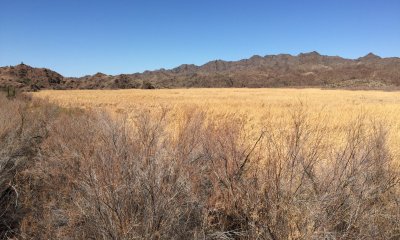
Sandy Bottom, Ciénaga 3"-7" p.z.
Scenario model
Current ecosystem state
Select a state
Management practices/drivers
Select a transition or restoration pathway
- Transition T1A More details
-
No transition or restoration pathway between the selected states has been described
Target ecosystem state
Select a state
Description
The plant community is dominated by facultative-wet or obligate herbaceous, grass-like wetland plants, such as cattail, sedge, and bulrush. A wide variety of other wetland species, such as pondweeds, stonewarts, and duckweeds, can occur on the site. Scattered cottonwood and willow may be present within the site, but are generally found at the margins where this site intermixes with Sandy Bottom, Woodland. In large inundated areas, such as the mouth of the Bill Williams River, trees occur on the edges. This ecological site is highly valuable wildlife habitat for songbirds, insects and mammals.
Description
This State is the current reference as non-native plants are found throughout this MLRA. Non-natives such as rush (Juncus acutus) and water fern (Azolla spp.) are known to occur. Saltcedar (Tamarisk spp.) may come to dominate the site, moving in from the margins and establishing during extended drought periods.
Model keys
Briefcase
Add ecological sites and Major Land Resource Areas to your briefcase by clicking on the briefcase (![]() ) icon wherever it occurs. Drag and drop items to reorder. Cookies are used to store briefcase items between browsing sessions. Because of this, the number of items that can be added to your briefcase is limited, and briefcase items added on one device and browser cannot be accessed from another device or browser. Users who do not wish to place cookies on their devices should not use the briefcase tool. Briefcase cookies serve no other purpose than described here and are deleted whenever browsing history is cleared.
) icon wherever it occurs. Drag and drop items to reorder. Cookies are used to store briefcase items between browsing sessions. Because of this, the number of items that can be added to your briefcase is limited, and briefcase items added on one device and browser cannot be accessed from another device or browser. Users who do not wish to place cookies on their devices should not use the briefcase tool. Briefcase cookies serve no other purpose than described here and are deleted whenever browsing history is cleared.
Ecological sites
Major Land Resource Areas
The Ecosystem Dynamics Interpretive Tool is an information system framework developed by the USDA-ARS Jornada Experimental Range, USDA Natural Resources Conservation Service, and New Mexico State University.
